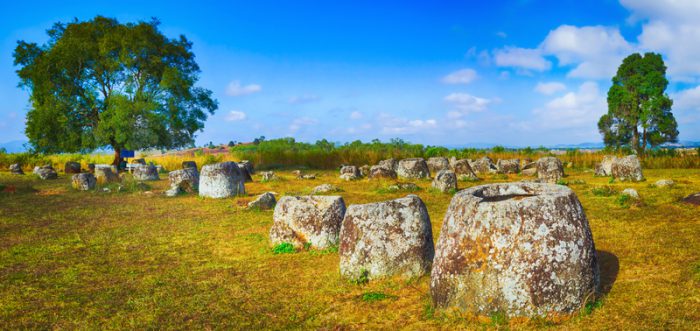The Plain of Jars may not ring a bell the same way as the Great Pyramids of Egypt, but perhaps it should. This incredible archeological site is not so much a single place as a landscape that stretches for many miles across central Laos.
Like the Egyptian pyramids, they may have been used in ancient burial rituals. And thanks to a new study, we now know that the stone jars are also about as old.
They date back as far as the second millennium BC, or at least 3,000 years ago. For context, this predates the classic Greek Empire and was at the same time as the Middle Kingdom of Egypt and the Babylonian Empire.
But what are the jars exactly? And if the site is so significant, why are we only dating them now?
Huge jars of stone
The jars stretch for miles and come in many different sizes. (Getty Embed)
The Plain of Jars features massive stone sculptures, or megaliths ('large stone'). There are thousands of them in total, spread out across about 90 different individual sites through the plain. Each of these sites can have anywhere from a few to a hundred or so jars.
Each jar ranges between 1 to 3 metres (3 to 10 feet) in height. Some have lids, but most are open.
So that's what they are. Now what was their purpose? That depends who you ask.
Laotian legends say that they belong to a time of giants and that they were used to store rainwater and distill (make) rice wine. Meanwhile, archeological studies from the early 2000s show that they are connected to burial and cremation (the ceremonial burning of human remains after death).
There seems to be truth to all of these things (well, maybe not the giants), but it is a tantalizing mystery that remains unclear to this day. The kind of question that archeologists live to solve. So why haven't they yet?
A big reason why? War.
Danger: Bombs
It is believed that this jar was broken by American bombs dropped during the mid-to-late 1960s. Leftovers from that war continue to make the area dangerous today. (Getty Embed)
As far back as the 1930s, archeologists were fascinated with the Plain of Jars. But that changed in the mid-1960s. At that point, the Vietnam War was spilling over into neighbouring Laos. As members of the North Vietnamese communist army took refuge in Laos, American planes bombed the country relentlessly. The end result was tragic and still stands today.
Despite huge campaigns to get rid of hundreds of thousands of unexploded bombs in the country, hundreds of Laotians die every year by accidentally triggering buried bombs. The Plain of Jars is just one area that has been affected in this way. And even though safe paths have been marked to visit some of the jars, much of the sites are still far too dangerous to visit.
Future exploration of the past
The Plain of Jars has been designated a UNESCO World Heritage Site. (Getty Embed)
All of which means that perhaps the biggest answers behind the Plain of Jars are still yet to be known.
Why did people build them? Did the way that they were used change over time? And how did people move such enormous megaliths?
For now, efforts to remove unexploded bombs from the area continue. We look forward to understanding more about such a curious site!
 Over 3,000 years after many of them were first made, the Plain of Jars in Laos is shrouded in mystery and danger. (Photo
Over 3,000 years after many of them were first made, the Plain of Jars in Laos is shrouded in mystery and danger. (Photo 








